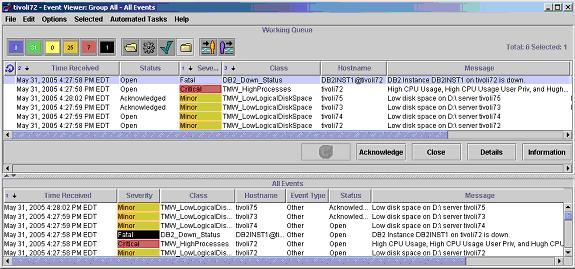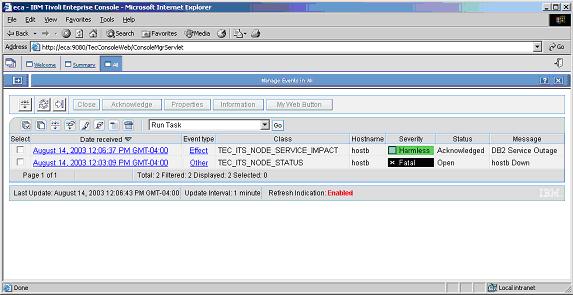Context
Tool mentors explain how a tool can perform tasks, which are part of ITUP processes and activities. The tasks are listed as Related Elements in the Relationships section.
You can see the details of how processes and activities are supported by this tool mentor, by clicking the links next to the icons:
Details
The IBM® Tivoli® Enterprise Console® product receives enterprise-wide event feeds from sources such as Tivoli software or
products from other vendors. An operator can readily discern availability events that reflect change in status by
viewing the Class or Message field of the Tivoli Enterprise Console event viewer.

The Tivoli Enterprise Console product provides event adapters, which are processes that monitor resources called
sources. A source can be an application, such as a database, or system resource, such as an application server. An
event adapter is a software program that collects information, performs local filtering, and converts relevant events
from sources into a format that can be used by the Tivoli Enterprise Console product. When an adapter detects an event
generated from a source, it formats the event and sends it to the event server. The event server then further processes
the event. Among the many events that are processed are availability events. To the Tivoli Enterprise Console product,
availability events are events that reflect a change in status, including that of services.
The following adapters are included with the Tivoli Enterprise Console product:
-
AS/400 alert adapter : monitors AS/400 alert filters (using data queues) for alerts. It formats
events and filters and sends them to the Tivoli Enterprise Console product.
-
AS/400 message adapter : extracts information from messages in the AS/400 message queue. It
formats the information into events, filters them, and sends them to the Tivoli Enterprise Console product.
-
NetWare® logfile adapter : gathers events from any ASCII log file residing on the NetWare server,
such as the SYS:SYSTEM\SYS$LOG.ERR file. It is a NetWare Loadable Module (NLM) process that reads events generated
on a NetWare server, formats them and forwards them to the event server for further processing.
-
OpenView Adapter : collects OpenView trap messages that have been sent by the OpenView trap daemon
(ovtrapd) and processed by the ovspmd daemon. The adapter translates the trap messages into the appropriate Tivoli
Enterprise Console event and forwards them to the Tivoli Enterprise Console product.
-
OS/2 adapter : an OS/2 process that reads events generated by an OS/2 system and
forwards them to an event server for further processing. OS/2 events are gathered from the First Failure Support
Technology (FFST) system, and from ASCII log files residing on the OS/2 system.
-
SNMP adapter : collects SNMP trap messages directly from the SNMP trap socket of a host and
translates SNMP traps into appropriate Tivoli Enterprise Console class instances.
-
UNIX® logfile adapter : receives raw log file information from the UNIX syslogd daemon, formats
it, and sends it to the Tivoli Enterprise Console product. The UNIX logfile adapter adds entries to the
/etc/syslog.conf file to enable the adapter to monitor events that the syslogd daemon writes to various log files.
The adapter can also be configured to monitor any ASCII log file for information that is important to the operation
of your enterprise.
-
Windows logfile adapter : a WIN32 process that reads events generated on a Windows 2000® system,
formats them according to the specification in the format file, and then forwards them using Winsock TCP/IP to an
event server for further processing. Events are gathered from up to six Windows event logs (System, Application,
Security, DNS server, File Replication service, and Directory service) maintained by the Windows Event Manager, and
from any other ASCII log files residing on the Windows 2000 system.
-
Distributed NetView® adapter : Distributed NetView-the network management
component of Tivoli Enterprise Console-monitors the network fabric that supports business applications. It is
tightly integrated with the Tivoli Enterprise Console product with an adapter that also formats, filters, and
forwards events to the Tivoli Enterprise Console product. An extensive Tivoli Enterprise Console NetView rule set
processes NetView events. NetView events are correlated, using an e-business rule set, with events from Tivoli
Monitoring events generated for business processes. NetView is able to discover services running on a node, and
when that node fails or a subnet becomes unreachable, NetView not only sends to the Tivoli Enterprise Console
product the node failure or subnet unreachable event but also sends a service impact event that indicates what
services are impacted by the node failure or subnet unreachable condition. In addition, NetView escalates the node
down event because the node is hosting a service that is crucial to the business operation. The combination of
these two events reflects the loss of availability of a network component and the resulting similar loss of a
service.

Using the Tivoli Event Integration Utility, users and third parties can develop their own adapters that are tailored to
their network environment and specific needs. With this facility, they can create an event listener, an application
that receives events and filters events at the source to reduce network traffic and offload the central event server.
The event listener then forwards the events to the Tivoli Enterprise Console product.
For availability reporting, the Tivoli Enterprise Console product comes with the Tivoli Data Warehouse Enablement Pack
Version 1.2 that extracts availability data from the Tivoli Enterprise Console database for outage reporting.
Availability data is examined against service level attainments by IBM Tivoli Service Level Advisor. Availability data
includes events that report a transition in the state of an object, such as an application or service shutting down.
The data extracted by the Tivoli Data Warehouse Enablement Pack can also be used to generate user-written reports for
trending purposes and the identification of current and potential issues.
For More Information
For more information about this tool, click on the link for this tool at the top of this page.
|


